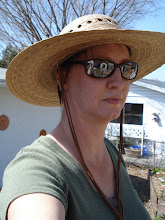 |
| Graduation Day |
How does this fit with the theme of the blog? Well, I try to keep it about living in a 'green' and eco-responsible way. Apparently moving is the both the Ultimate Test of Living Green, as well as a good opportunity to not only talk the green talk, but also walk the green walk. Let's start with the basics: Reduce, Reuse, Recycle. It turns out that they're all connected.
1. Reduce. Those of you who know us know that we live in a pretty tiny house. Less than 800 square feet inside, with a substantially sized glassed-in porch that we don't count as living space. What genius thought that glassing in a sun porch in Florida was a good idea is beyond me. The house we're buying (We've named it "Little Boone") is slightly larger at just over 1100 sq. ft. We already don't have what we consider to be a lot of stuff, but probably had kept a little more than we might have otherwise because in our minds 'the next house will be bigger.' Well, yes... but not enough to really count. So we've been reducing like crazy. I've gone through just about every room in the house and have found things I think we can live without. The hardest decisions for me were shoes and pens. I expected to have some separation anxiety and guilt over the culling of the shoes. I loves me some shoes, people! None are crazy cute heels. All are cute, sensible and comfy. Merrills, Chacos, Keens, OH MY! I probably should have taken the opportunity to count the ones that made the cut, but I forgot, and now the winter-ish ones are packed. Oh, Darn. Now we'll never know how many I have (and stop calling me Imelda!) The pens, now, were a surprise. It wasn't that I was somehow emotionally attached to the pens. I just didn't want to be environmentally irresponsible and throw out perfectly good pens, and who would buy a used pen at the thrift store?? But how many pens do two people in the age of digital communication really need? My reduction in pens and other associated writing implements resulted in the use of another of the Three R's: reuse. I gave them to a school teacher for use in the classroom. As a former teacher, I get how much of your own money you spend on basics, so I felt much better that my reduction was someone else's gain, and that I didn't have to clog up a landfill with half-used gel-pens from my paper journaling phase.
2. Reuse. This one was a bit easier. We had a need to reduce, and we knew a lot of our stuff was re-usable. One of the girls at our favorite local Tea Shop, TeBella Tea Company, was getting her very first apartment. I'm not the maternal type, generally, but if I had wanted a daughter to call my own, Brooke would be it. She's smart, strong, hard-working and responsible. She manages to be all those things and also be just the sweetest kid on earth. She also needed "stuff." And boy did we have stuff to spare. While I was doing my Reducing, I kept a "Brooke Box," and managed to fill it several times over with all kinds of kitchen supplies as well as our kitchen table and chairs. By reducing the amount of stuff we were having to move, Brooke is able to reuse some of it. Warms the cockles of my hippie green heart, it does.
3. Recycle. I had fun with this one. I recycled a bunch of old t-shirts into yarn a while back, and realized how many crafty activities can benefit from recycling. Right around the time we started getting ready to move, a really cool business opened up in Ybor City. It's called Tampa Upcycle. Morgan takes in all kinds of supplies that crafters and artist no longer need and provides a place for them to live until another crafter or artist comes by and gives them a home. She puts it best on her website: "Tampa Upcycle is an arts and crafts supplies boutique that collects and offers used (and some new) art supplies such as paints, canvasses and brushes, sewing supplies such as fabrics, notions, and patterns, and craft supplies such as scrapbooking papers and embellishments, yarns and tools with “pay-as-you-wish” pricing. The idea is to have a central location where indie artists, designers and crafters can find materials that can be repurposed and made into something new. Everything from partially used paints to vintage sheets to cereal boxes." Isn't that just the coolest? It appeals to me on so many levels. Another box was soon filled with Tampa Upcycle stuff. I took every scrap of wrapping paper, gift bags, little glass bottles, and all kinds of crafty supplies up there and donated them. I would love to be a part of something community-minded like that when we move. I recently took a class to reacquaint myself with my decades-old sewing machine at Tampa Upcycle offered by Tampa FreeSkool. FreeSkool is community based education in action. Basically, if you have something you know how to do, and can teach it to others for free, you are encouraged to do so. Things like beer making, to friend-making, to yoga, to fun with compost. Recycling your knowledge, in a way, and making it available to those who want to learn for themselves. This is something else I'd love to get going in Tennessee, if it doesn't already exist.
 |
| Little Boone |















